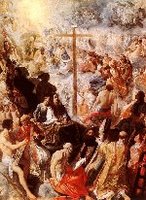This flimsy gimcrack charade

I felt a wave of nausea when I walked into Ron Mueck's exhibition at the National Galleries of Scotland. No, this is not the prelude to a rave review that goes on to explain how the visceral realism of Mueck's models disturbed and moved me to my very gut. The sickness I felt was at the prospect of having to waste time, and words, on this flimsy gimcrack charade, on having to walk around with a straight face and pretend this is an exhibition. Of art.
We agree, most of us, that in principle almost anything can be art. So how does it become art? By speaking, in however removed and subtle a way, the language of art, by referring to the idea of art. All art does this, even the most tragic and extreme representation of pain: every crucifixion refers to every other crucifixion.
The art that most aggressively refuses to do so is realism, and Mueck is a realist. The best way to understand his appeal is to recognise that he is your common or garden realistic figurative artist, who has translated into the mass-media technology of our time the same piddling mediocre misery that British painters from Euan Uglow to Jenny Saville have lumbered us with. It's that vaguely pathetic, tedious tradition the critic David Sylvester dubbed "kitchen sink", remade in silicone and fibreglass.
These are simply people, Mueck's models declare, with their grey, waxy flesh. We're supposed to respond to them as we might to ourselves in a mirror that magnified all our chest hairs and wrinkles. But nothing is so simple. Mueck's art is presumed to work by being eye-fooling, but it fails even on that primitive level. The flesh is too pink, or too yellow - and, always, too still. It's a parody of people. Mueck's confused enterprise shrinks on analysis. The Edinburgh Art festival, now in its third year, will have to offer something better than this dumb bathos if it is to become a truly vital companion to the theatre, music, book and film festivals.
Excellent combative journalism from Jonathan Jones writing in today’s Guardian about the Ron Mueck exhibition that I wrote about on Sunday. It is a very well argued piece, but I do think his comparison of the work of Ron Mueck and the German late-Renaissance artist Adam Elsheimer (below) misses a point.
 We simply don’t have to choose between Mueck and Elsheimer, or between Stockhausen and Bach any more. Technology advances, together with increased disposable incomes and leisure time mean we can now have Mueck and Elsheimer, and Stockhausen and Bach. In fact the art of Mueck and Stockhausen couldn’t have existed in the late-Renaissance because it is the product of that new technology. We now live in a plural culture, and that means we can have Mueck, Elsheimer, Stockhausen and Bach, and I for one am very thankful for that. When St. Thérèse of Lisieux was four she was offered a handful of ribbons to choose from. 'I choose all' she said.
We simply don’t have to choose between Mueck and Elsheimer, or between Stockhausen and Bach any more. Technology advances, together with increased disposable incomes and leisure time mean we can now have Mueck and Elsheimer, and Stockhausen and Bach. In fact the art of Mueck and Stockhausen couldn’t have existed in the late-Renaissance because it is the product of that new technology. We now live in a plural culture, and that means we can have Mueck, Elsheimer, Stockhausen and Bach, and I for one am very thankful for that. When St. Thérèse of Lisieux was four she was offered a handful of ribbons to choose from. 'I choose all' she said.Read the full article via this link and make up your own mind. And more on the Edinburgh Festival here on Friday.
Photo credits. Ron Mueck's A Girl, photograph: Murdo MacLeod via Guardian. Adam Elsheimer's Glory of the Cross from L'Atelier Robert Coane. Any copyrighted material on these pages is included as "fair use", for the purpose of study, review or critical analysis only, and will be removed at the request of copyright owner(s). Report broken links, missing images and other errors to - overgrownpath at hotmail dot co dot uk
If you enjoyed this post take An Overgrown Path to Danish thread









Comments